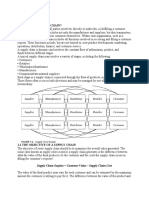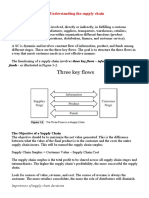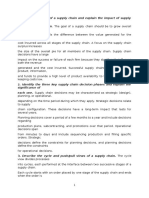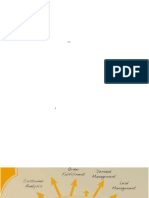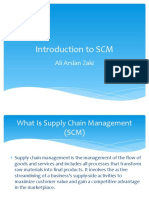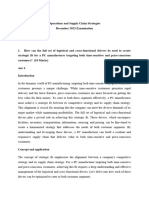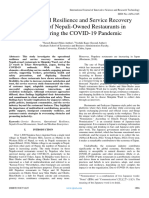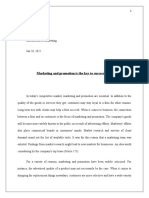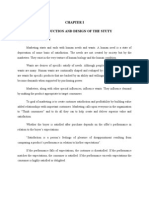0 ratings0% found this document useful (0 votes)
5 Supply Chain Value
5 Supply Chain Value
Uploaded by
asghar.raza.cpoCopyright:
© All Rights Reserved
Available Formats
Download as PPTX, PDF, TXT or read online from Scribd
Download as pptx, pdf, or txt
5 Supply Chain Value
5 Supply Chain Value
Uploaded by
asghar.raza.cpo0 ratings0% found this document useful (0 votes)
Copyright
© © All Rights Reserved
Available Formats
PPTX, PDF, TXT or read online from Scribd
Share this document
Did you find this document useful?
Is this content inappropriate?
Copyright:
© All Rights Reserved
Available Formats
Download as PPTX, PDF, TXT or read online from Scribd
Download as pptx, pdf, or txt
0 ratings0% found this document useful (0 votes)
5 Supply Chain Value
5 Supply Chain Value
Uploaded by
asghar.raza.cpoCopyright:
© All Rights Reserved
Available Formats
Download as PPTX, PDF, TXT or read online from Scribd
Download as pptx, pdf, or txt
You are on page 1/ 15
5
Supply Chain Value
Ahmed Ata Khan
Stages of a Supply Chain
Objective of Supply Chain
Supply Chain Surplus =
Consumer Value –
Supply Chain Cost
The value of the final product may vary for each
customer and can be estimated by the maximum
amount the customer is willing to pay for it.
The difference between the value of the product and
its price remains with the customer as consumer
surplus.
The rest of the supply chain surplus becomes supply
chain profitability, the difference between the
revenue generated from the customer and the overall
cost across the supply chain.
Detergent Supply Chain
Value of a Supply Chain
For any supply chain, there is only one
source of revenue:
The Customer
The value obtained by a customer
purchasing detergent at Wal-Mart depends
upon several factors:
◦ The competitive price of the detergent
◦ The functionality of the detergent
◦ How far the customer has to travel to Wal-Mart
◦ The likelihood of finding the detergent in stock
Effectiveness of a Supply Chain
The customer is the only one providing positive cash flow
for the Wal-Mart supply chain
All other cash flows are simply fund exchanges that occur
within the supply chain, given that different stages have
different owners.
When Wal-Mart pays its supplier, it is taking a portion of the
funds the customer provides and passing that money on to
the supplier.
All flows of information, product, or funds generate costs
within the supply chain.
The appropriate management of these flows is a key to
supply chain success.
Effective supply chain management involves the
management of supply chain assets and product, information,
and fund flows to maximize total supply chain surplus.
Importance of Supply Chain Decisions
Wal-Mart Example
There is a close connection between the design and
management of supply chain flows (product, information, and
funds) and the success of a supply chain.
Wal-Mart has been a leader at using supply chain design,
planning, and operation to achieve success.
From its beginning, the company invested heavily in
transportation and information infrastructure to facilitate the
effective flow of goods and information.
Wal-Mart designed its supply chain with clusters of stores
around distribution centers to facilitate frequent replenishment
at its retail stores in a cost-effective manner.
Frequent replenishment allows stores to match supply and
demand more effectively than the competition.
Wal-Mart has been a leader in sharing information and
collaborating with suppliers to bring down costs and improve
Seven-Eleven Japan Example
Seven-Eleven Japan is another example of a
company that has used excellent supply chain design,
planning, and operation to drive growth and
profitability.
It has used a very responsive replenishment system
along with an outstanding information system to
ensure that products are available at each of its
convenience stores to match customer needs.
It’s responsiveness allows it to change the
merchandising mix at each store by time of day to
precisely match customer demand.
As a result, the company has grown from sales of 1
billion yen in 1974 to almost 3 trillion yen in 2009
DELL Example
Dell is another example of a company that enjoyed
tremendous success based on its supply chain design,
planning, and operation but then had to adapt its supply chain
in response to shifts in technology and customer expectations.
Between 1993 and 2006, Dell experienced an unprecedented
growth of both revenue and profits by structuring a supply
chain.
This success was based on two key supply chain features that
supported rapid, low-cost customization.
The first was Dell’s decision to sell directly to the end
customer, bypassing distributors and retailers.
The second key aspect of Dell’s supply chain was the
centralization of manufacturing and inventories in a few
locations where final assembly was postponed until the
customer order arrived.
Decision Phases in a Supply Chain
1. Supply Chain Strategy or Design
◦ During this phase, a company decides how to
structure the supply chain over the next several years.
◦ It decides what the chain’s configuration will be, how
resources will be allocated, and what processes each
stage will perform.
◦ Strategic decisions made by companies include
whether to outsource or perform a supply chain
function in-house, the location and capacities of
production and warehousing facilities, the products
to be manufactured or stored at various locations, the
modes of transportation to be made available along
different shipping legs, and the type of information
system to be utilized.
Decision Phases in a Supply Chain
2. Supply Chain Planning
◦ For decisions made during this phase, the time frame
considered is a quarter to a year.
◦ Therefore, the supply chain’s configuration determined in
the strategic phase is fixed.
◦ This configuration establishes constraints within which
planning must be done.
◦ The goal of planning is to maximize the supply chain
surplus that can be generated over the planning horizon
given the constraints established during the strategic or
design phase.
◦ Planning includes making decisions regarding which
markets will be supplied from which locations, the
subcontracting of manufacturing, the inventory policies to
be followed, and the timing and size of marketing and price
Decision Phases in a Supply Chain
3. Supply Chain Operation
◦ During this phase, companies make decisions regarding
individual customer orders.
◦ At the operational level, supply chain configuration is
considered fixed, and planning policies are already defined.
◦ The goal of supply chain operations is to handle incoming
customer orders in the best possible manner.
◦ During this phase, firms allocate inventory or production to
individual orders, set a date that an order is to be filled,
generate pick lists at a warehouse, allocate an order to a
particular shipping mode and shipment, set delivery
schedules of trucks, and place replenishment orders.
◦ Given the constraints and planning policies, the goal during
the operation phase is to exploit the reduction of uncertainty
and optimize performance.
Supply Chain Macro Processes in a Firm
All supply chain processes discussed in the two process views and
throughout this book can be classified into the following three
macro processes, as shown :
1. Customer Relationship Management (CRM): all processes that
focus on the interface between the firm and its customers
2. Internal Supply Chain Management (ISCM): all processes that
are internal to the firm
3. Supplier Relationship Management (SRM): all processes that
focus on the interface between the firm and its suppliers
Supply Chain Macro Processes in a Firm
These three macro processes manage the flow of information,
product, and funds required to generate, receive, and fulfill a
customer request.
The CRM macro process aims to generate customer demand and
facilitate the placement and tracking of orders. It includes processes
such as marketing, pricing, sales, order management, and call center
management.
The ISCM macro process aims to fulfill demand generated by the
CRM process in a timely manner and at the lowest possible cost.
ISCM processes include the planning of internal production and
storage capacity, preparation of demand and supply plans, and
fulfillment of actual orders.
The SRM macro process aims to arrange for and manage supply
sources for various goods and services. SRM processes include the
evaluation and selection of suppliers, negotiation of supply terms,
and communication regarding new products and orders with
Quiz on 19 January,
from Chapters 4 & 5
Best of Luck
You might also like
- Logistics and Supply Chain Management: Dr. R. S. GhoshNo ratings yetLogistics and Supply Chain Management: Dr. R. S. Ghosh164 pages
- Global Supply Chain Management Notes-Msc Procurement and Logistics-Sept, 2023No ratings yetGlobal Supply Chain Management Notes-Msc Procurement and Logistics-Sept, 202385 pages
- Chapter 1: Understanding The Supply ChainNo ratings yetChapter 1: Understanding The Supply Chain5 pages
- Logistics and Supply Chain Management MBA 3rd Sem Nagpur University100% (1)Logistics and Supply Chain Management MBA 3rd Sem Nagpur University31 pages
- Supply Chain: Supply Chain Management Is Primarily Concerned With The Efficient Integration ofNo ratings yetSupply Chain: Supply Chain Management Is Primarily Concerned With The Efficient Integration of24 pages
- Ome752 Supply Chain Management Unit - I IntroductionNo ratings yetOme752 Supply Chain Management Unit - I Introduction21 pages
- CH - 01 (Understanding Supply Chain Management)No ratings yetCH - 01 (Understanding Supply Chain Management)37 pages
- Chain Decisions On The Success of A Firm. The Goal of A Supply Chain Should Be To Grow OverallNo ratings yetChain Decisions On The Success of A Firm. The Goal of A Supply Chain Should Be To Grow Overall8 pages
- Lecture Notes: Long Lead Times Customer ExpectationsNo ratings yetLecture Notes: Long Lead Times Customer Expectations19 pages
- Lesson 2 - Supply Chain Objectives and DecisionsNo ratings yetLesson 2 - Supply Chain Objectives and Decisions32 pages
- Lecture 1 - Understanding The Supply ChainNo ratings yetLecture 1 - Understanding The Supply Chain36 pages
- Lecture 2 - Supply Chain Performance Achieveing Strategic Fit and ScopeNo ratings yetLecture 2 - Supply Chain Performance Achieveing Strategic Fit and Scope28 pages
- PGDSCM: Post Graduate Diploma in Supply Chain ManagementNo ratings yetPGDSCM: Post Graduate Diploma in Supply Chain Management23 pages
- Supply Chain Management Lecture Notes Ome752No ratings yetSupply Chain Management Lecture Notes Ome75238 pages
- Operations and Supply Chain Strategies CA1No ratings yetOperations and Supply Chain Strategies CA111 pages
- SCM - Objective, Fows, and Decision PhasesNo ratings yetSCM - Objective, Fows, and Decision Phases8 pages
- Military Supply Chain Management: From Deployment to Victory, Mastering the Logistics DanceFrom EverandMilitary Supply Chain Management: From Deployment to Victory, Mastering the Logistics DanceNo ratings yet
- Supply Chain Business Startup Guide: Step-by-Step Tips for SuccessFrom EverandSupply Chain Business Startup Guide: Step-by-Step Tips for SuccessNo ratings yet
- Goetsch QM 9e PPT Accessible Fullppt 07No ratings yetGoetsch QM 9e PPT Accessible Fullppt 0743 pages
- Services Marketing Lovelock Wirtz Chaterjee CH 08No ratings yetServices Marketing Lovelock Wirtz Chaterjee CH 0827 pages
- Operational Resilience and Service Recovery Strategies of Nepali-Owned Restaurants in Japan During The COVID-19 PandemicNo ratings yetOperational Resilience and Service Recovery Strategies of Nepali-Owned Restaurants in Japan During The COVID-19 Pandemic7 pages
- Beyond Expectations - Excellent Customer Service One-PagerNo ratings yetBeyond Expectations - Excellent Customer Service One-Pager2 pages
- Literature Review On Communication Satisfaction100% (1)Literature Review On Communication Satisfaction6 pages
- I. Statement of The Problem: A. Productive Objective100% (1)I. Statement of The Problem: A. Productive Objective3 pages
- Mediating Effect of Customer Perceive Value On Experience Quality and Loyalty RelationshipNo ratings yetMediating Effect of Customer Perceive Value On Experience Quality and Loyalty Relationship13 pages
- A Study On Consumer Buying Behavior Towards Purchase of Used Car'sNo ratings yetA Study On Consumer Buying Behavior Towards Purchase of Used Car's85 pages
- Michael Murchie Resume Final Draft Revised Geb 3033No ratings yetMichael Murchie Resume Final Draft Revised Geb 30334 pages
- MARK5814 - T1 2022 Digital Marketing of Cotton:On Individual Assignment Student Name: Word CountNo ratings yetMARK5814 - T1 2022 Digital Marketing of Cotton:On Individual Assignment Student Name: Word Count11 pages
- Logistics and Supply Chain Management: Dr. R. S. GhoshLogistics and Supply Chain Management: Dr. R. S. Ghosh
- Global Supply Chain Management Notes-Msc Procurement and Logistics-Sept, 2023Global Supply Chain Management Notes-Msc Procurement and Logistics-Sept, 2023
- Logistics and Supply Chain Management MBA 3rd Sem Nagpur UniversityLogistics and Supply Chain Management MBA 3rd Sem Nagpur University
- Supply Chain: Supply Chain Management Is Primarily Concerned With The Efficient Integration ofSupply Chain: Supply Chain Management Is Primarily Concerned With The Efficient Integration of
- Ome752 Supply Chain Management Unit - I IntroductionOme752 Supply Chain Management Unit - I Introduction
- Chain Decisions On The Success of A Firm. The Goal of A Supply Chain Should Be To Grow OverallChain Decisions On The Success of A Firm. The Goal of A Supply Chain Should Be To Grow Overall
- Lecture Notes: Long Lead Times Customer ExpectationsLecture Notes: Long Lead Times Customer Expectations
- Lecture 2 - Supply Chain Performance Achieveing Strategic Fit and ScopeLecture 2 - Supply Chain Performance Achieveing Strategic Fit and Scope
- PGDSCM: Post Graduate Diploma in Supply Chain ManagementPGDSCM: Post Graduate Diploma in Supply Chain Management
- Military Supply Chain Management: From Deployment to Victory, Mastering the Logistics DanceFrom EverandMilitary Supply Chain Management: From Deployment to Victory, Mastering the Logistics Dance
- Summary of Daniel Stanton's Supply Chain Management For DummiesFrom EverandSummary of Daniel Stanton's Supply Chain Management For Dummies
- Supply Chain Business Startup Guide: Step-by-Step Tips for SuccessFrom EverandSupply Chain Business Startup Guide: Step-by-Step Tips for Success
- How to Optimise Your Supply Chain to Make Your Firm Competitive!From EverandHow to Optimise Your Supply Chain to Make Your Firm Competitive!
- Operational Resilience and Service Recovery Strategies of Nepali-Owned Restaurants in Japan During The COVID-19 PandemicOperational Resilience and Service Recovery Strategies of Nepali-Owned Restaurants in Japan During The COVID-19 Pandemic
- Beyond Expectations - Excellent Customer Service One-PagerBeyond Expectations - Excellent Customer Service One-Pager
- I. Statement of The Problem: A. Productive ObjectiveI. Statement of The Problem: A. Productive Objective
- Mediating Effect of Customer Perceive Value On Experience Quality and Loyalty RelationshipMediating Effect of Customer Perceive Value On Experience Quality and Loyalty Relationship
- A Study On Consumer Buying Behavior Towards Purchase of Used Car'sA Study On Consumer Buying Behavior Towards Purchase of Used Car's
- Michael Murchie Resume Final Draft Revised Geb 3033Michael Murchie Resume Final Draft Revised Geb 3033
- MARK5814 - T1 2022 Digital Marketing of Cotton:On Individual Assignment Student Name: Word CountMARK5814 - T1 2022 Digital Marketing of Cotton:On Individual Assignment Student Name: Word Count




